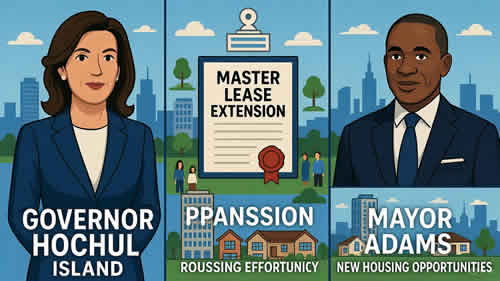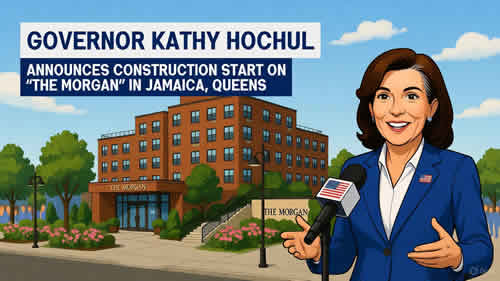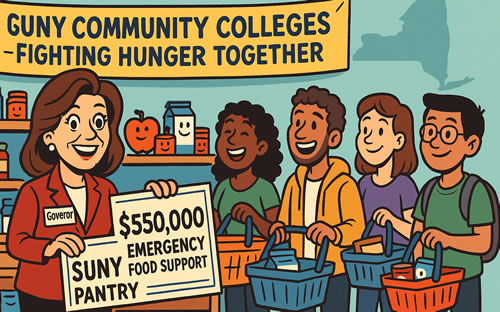August 9, 2023
Mayor Eric Adams: My fellow New Yorkers, immigration is the New York City story. It is the American story. It is a story of those who board its ships to reach these shores, the huddled masses yearning to breathe free.
For centuries, immigrants have made that remarkable journey, that leap of faith, searching for freedom, safety, a shot at the American Dream. And the asylum seekers who have arrived in our city since last spring are writing a new chapter in this timeless story.
But as I declared nearly a year ago, we are facing an unprecedented state of emergency. The immigration system in this nation is broken. It has been broken for decades. Today, New York City has been left to pick up the pieces. Since last year, nearly 100,000 asylum seekers have arrived in our city asking for shelter. Let me repeat. Almost 100,000 men, women, and children have asked for a place to stay. That’s almost the population of Albany, New York. And for more than a year, thousands of people across this administration, and more than 100 community-based organizations, have worked tirelessly to ensure that every person who has arrived here gets the opportunity to build their New York City dream.
They do not have the authorization to work, so we have to provide shelter. We have supplied food and access to healthcare. We have enrolled children in schools. We have opened almost 200 emergency sites, including more than a dozen large scale humanitarian relief centers. And we have assisted migrants with asylum applications.
But we are past our breaking point. New Yorkers’ compassion may be limitless, but our resources are not. And our partners at the state and federal levels know this. We continue to face impossible decisions about allocating our resources, and that means a lose-lose for our most vulnerable New Yorkers as well as those seeking asylum.
We saw the effects clearly last week outside the Roosevelt Hotel. Adult asylum seekers were sleeping on the pavement because our shelter system was full. I went again and again to speak with the men there. It broke my heart. It breaks this city’s heart. Asylum seekers come here in search of a dream, not a nightmare. They come to work, to contribute to our city and our nation’s success. But the scenes outside the Roosevelt may sadly become more common if we don’t get the support we need.
Our city is already facing a severe housing shortage, on top of trying to find space for our new arrivals. We have repeatedly asked state lawmakers to assist in building more affordable homes, but they have been unable to pass any meaningful legislation. And the costs have grown from our earlier estimates as more people continue to arrive. This is not sustainable.
Let me put it in perspective for New Yorkers. For each family seeking asylum through the city’s care, we spend an average of $383 per night to provide shelter, food, medical care, and social services. With more than 57,300 individuals currently in our care, on an average night, it amounts to $9.8 million a day, almost $300 million a month, and nearly $3.6 billion a year.
But this is the floor, not the ceiling. This is only an estimate if the number of migrants in our care stays the same over time. It is clear to us, however, that without policy changes, the number of migrants arriving will continue to grow. This will increase our cost. If we continue down this unsustainable track, with an average of almost 34,000 households a night over the course of just this fiscal year, that will increase cost to $4.7 billion.
Hear me, if things do not change, our new estimates have us spending nearly $5 billion on this crisis in the current fiscal year. That’s up from the $1.4 billion we spent last fiscal year. And it nearly equals the budgets of the Sanitation Department, our Parks Department, and the FDNY combined.
And if things do not change, we expect to have more than 100,000 asylum seekers in our care by the end of June, 2025, driving projected spending to $6.1 billion in that fiscal year if we do not change course. That means over the course of three fiscal years, our city is projected to have spent more than $12 billion.
To meet this need, we’ll have to add $7 billion to our financial plan. And this is on top of what we previously allocated for the crisis. This is the budgetary reality we are facing if we don’t get the additional support we need from the federal and state governments.
This is not just about numbers. This is about people fleeing despair and trauma. I have greeted asylum seekers at the Port Authority. I have slept by their side on the coldest day of the year, and I have sat with a mother whose husband was lost to this crisis. She now faces raising her three children alone.
The city is running out of money, appropriate space, and personnel to care for families like hers. We’re grateful to Governor Hochul for all she has done to help our city, but the number of asylum seekers increasing, we need more from our state partners. And I want to thank US Senate Majority Leader Schumer, Democratic Leader Jeffries, and members of the New York City Congressional Delegation for all the efforts at the federal level to get us the support we need.
New Yorkers did not create an international humanitarian crisis, but New Yorkers have been left to deal with this crisis almost entirely on our own. It has been fueled by those in Congress who stand in the way of real immigration reform, by governors who have used vulnerable asylum seekers as political pawns, by the indifference of leaders across the nation.
Now let me be clear, New York City will not abandon our brothers and sisters seeking the American dream. Thanks to the teamwork of so many, both in and outside of government, including our faith based and nonprofit partners, we have done more than any city to provide for so many migrants in such a short period of time. We have met a historic crisis with historic compassion.
And while we are past our breaking point, we will never just slam the door of opportunity. We have had productive conversations with our state and federal partners, and they show real commitment to supporting our efforts, but we need additional resources.
Now, the best way to solve this problem is by all of us working together. The state can support us by taking reasonable actions to ease the burden of our city. We need a statewide decompression strategy to help free up space in our shelter system and reduce the pressure on our city’s resources. The state recently announced humanitarian relief centers that they will reimburse us for, but we need more. The state can also allocate more funding to match our needs on the ground. And we are willing to work with every locality across New York State to provide support for asylum seekers because they need to play their part just like Buffalo, White Plains and others have.
If these actions are taken, they will ease the burden on our city’s resources and will enable us to reevaluate the impact on our budget. And while many Republicans in Congress may be holding up critical reform, the White House can help us now. I agree with Massachusetts Governor Healey, the federal government must take action. We appreciate them sending a team from the US Department of Homeland Security to New York City to assess the situation this week. There’s more they can do, including expediting pathways to work authorizations for asylum seekers. I have heard it directly from all the asylum seekers I’ve spoken with, they want to work. There’s nothing more anti-American than not letting people work. Imagine the boost to our nation’s economy if we were to fill the hundreds of thousands of jobs that need workers right now. It’s the right thing to do, and it is smart economics.
We’re also asking the federal government to declare a state of emergency. This will allow federal funds to be allocated quickly to help address the urgent challenges we face. Additionally, federal government needs to provide more funding to match the reality of the course on the ground.
Finally, we need the federal government to lead a decompression strategy at the border so cities and states across the nation can do their part to shelter asylum seekers. Because cities like New York, Boston, Chicago, Los Angeles, Houston, and El Paso cannot be left to shoulder a national crisis without the proper aid.
Again, if we don’t get the support we need, New Yorkers could be left with a $12 billion bill. So while New York City will continue to lead, it’s time the state and federal government step up.
We will continue to do more than any other city or level of government in the nation to accommodate asylum seekers because that’s who we are, a city of empathy, of compassion and care. And we know, in the long run, asylum seekers will contribute to our strength, like so many before them. They have already begun to make homes, to give back to their communities, to become New Yorkers.
As President Obama has said, we were once strangers too. 14% of all Americans can trace their heritage to Ellis Island right here in New York Harbor. This city and this nation have been shaped by those who we have welcomed. Immigrants are our friends, our families, our neighbors. They are the hardworking New Yorkers who make life here possible. This is the magic of this city, people of all backgrounds living together in one place. New York City remains a beacon for all who come to our shores. And we will continue to uphold these values and reach out a helping hand to those in need. This is the New York City way. It is time for that to be the American way again.
[…]
Question: Hi, Mr. Mayor.
Mayor Adams: How are you?
Question: I’m good. Could you or somebody up here break down the $12 billion projected cost you just talked about in terms of how much of that is going towards actual housing and how much is going towards social services, legal services, health services? Can somebody just give us a sense of how that is estimated to break down over the next few years?
Mayor Adams: Yeah. First of all, I thank God when Jacques came on board he was already baldheaded, because he would’ve lost all his hair by now. So Jacques, why don’t you come give some of these numbers.
Jacques Jiha, Director, Mayor’s Office of Management and Budget: There’s going to be a technical briefing after 1:30. I could get into the detail with you, but most of the cost basically is of course of shelter, because the cost is driven by the census. So as we have more people coming to the system, that’s what we have to shelter a lot more people. So that’s should drive the cost, but I would provide you my information at the technical briefing.
Question: Mayor, did you guys submit the list to the state when it comes to needs, and are you guys on the same page with the state? Because I’m hearing resources within the government administration saying that they don’t believe that they have to uphold this court order from the judge last week.
Mayor Adams: All this is going to be played out in court. The judge is going to determine what must be done and what shouldn’t be done. We want to focus on how do we operate as a partner to navigate us through these extremely difficult times. And Judge Radix, the corp counsel, she’s going to discuss what we need to do when we get back into the courtroom. But again, we want to thank what the governor has done with our congressional delegation, what they have done as well, but we laid out our case. The potentiality that New York City residents are going to have a $12 billion potential price tag over the three fiscal years is something we have to deeply think about. We talking about $12 billion in addition to what we already need to run this city, and it’s just unfair for New Yorkers to carry that burden.
Question: [Inaudible] letter to the state with those needs?
Mayor Adams: Yes. Judge?
Question: [Inaudible.]
Mayor Adams: What’s that new movie that’s out? [inaudible 00:02:42].
Judge Sylvia Hinds-Radix, Corporation Counsel, Law Department: I guess I grew hair, right? Good morning. The Callahan document requires that the court have conferences in chambers. That’s why there has not been a lot of publicity with reference to what the court is requesting. The document that you just referred to with reference to request for a letter happens to be a court order. We are going to comply with the court’s request and the court’s order. We have no idea who is not going to do that. You ask the mayor whether that cannot be done, he doesn’t know, but we know that this is an order from the court and we expect that it will be followed.
Question: Yeah. Mr. Mayor, I’m wondering if you might be able to address how this situation might define your administration as you prepare for reelection. I know it’s early, but I know that this is overshadowing a lot of work that you have done. How do you extricate yourself politically from this situation?
Mayor Adams: Well, no, this situation has not overshadowed the success of this administration. You guys are just not covering the success of this administration. When you look at what this team has done around record levels of people who we put in housing, what we’ve done around public safety, the decrease in crime, what we’ve done. Investment in children, summer youth employment. This administration, we are going to have a clear record of how well we have dealt with this crisis.
And listen, every mayor had a crisis that he had to handle. Bloomberg had 9/11. De Blasio had Covid. You don’t sit back as a mayor and say, “Woe is me.” You say, “Why not me?” I want the ball. This is the city that I love, that I protected as a police officer. This is the city I want to lead. I thank God every day that I’m the mayor of the city right now during these difficult times, and we’re going to continue to move the ball down the field.
I have an amazing team. They’re dedicated. They’re committed to what we do, and it’s a blessing that we have Deputy Mayor Williams-Isom who’s coordinating this, a military expert, and Zach Iscol, a person who’s a dreamer that’s in charge of immigrant affairs. When you look at where we are, we are going to manage this as we manage all the other items that we have to deal with.
This is a blemish. Don’t interrupt me. Please don’t interrupt me. I do not interrupt when you ask questions, don’t interrupt when I’m answering them. And you could ask your question as long as you want, and I’m going to answer as long as I want. That’s the rules that we did day one when I became the mayor. The blemish is not on this administration. The blemish is on the national government that we are allowing this crisis to fall in the lap of our local municipalities. That’s the blemish. We are going to do our job. That’s my job to protect the people of this city and everyone in this city, and I’m going to do that job. Now, you wanted to finish up or let him finish. Go ahead. You had another part of it. Yes?
Question: Well actually, I have a follow up question, Mr. Mayor. I’m wondering now, you are the face of this crisis right now. People see you struck with this crisis. How do you address New York City to reassure them that you’ve got things under control?
Mayor Adams: You said people see me struggling?
Question: Yeah, with the situation. We are, as you said, in a crisis, right?
Mayor Adams: Yes. But I’m not struggling. I’m managing a crisis and anyone who has managed a crisis before know that the leadership is important. We went over a year, I think this started in April. We went over a year when we had 15,000, I stated it was time to call the state of emergency. We went over a year. What we were successful in doing, one, as we stated, we want no child and family to be sleeping on the streets.
We were successful in doing that. We were able to shield, for the most part, the New York City public from the depth of this crisis. For a year we managed what we were going through night, after night after night, and people were able to carry out their regular days because of how we managed that. And so I’m the face of a successful city that successfully is doing when no other city has been able to do at the magnitude that we have been able to do. That’s the face you’re see, you seeing the face of a good manager with a good team managing a crisis that we are facing.
Question: Thank you. [Inaudible] Mr. Mayor, about how many students the school system is preparing for and how [inaudible]?
Mayor Adams: During Jacques’ technical briefing, he’ll go through that, but we don’t know the exact number because this is a moving target. The latest round of asylum seekers and migrants we receiving, there’s a large number of children and families. And so it’s a moving number and it’s difficult to say exactly how much. Our chief of staff had a meeting. We called the state to prepare them, state education, to prepare them of the potentiality of what we are facing. But we have been successful through the chancellor and through the entire DOE team, we have been successful in absorbing those young people to make sure no child is going without education in our school systems. We don’t have the exact number because it’s a continuing, growing and moving number.
Question: Mr. Mayor, at what point is the sympathetic, empathetic right thing to do for the entire city? At what point is it that you either turn away the migrants or bus them to other places because the city has reached its breaking point, as you say, “We’ve crossed that breaking point?” And my second question is at what point, what has the Biden administration told you specifically as to why they have sent as little money as they have sent so far?
Mayor Adams: Well, we are going to never reach the point where we are going to do what those governors did, just using migrants as political pawns. We’re never going to do that. And we are at the breaking point. What you saw outside the Roosevelt Hotel a few days ago was because as we stated, there was no more room. There was just no more room. And we had to, until we were able to find new spaces, we had to temporarily have people that was outdoors.
And I went there, I spoke with those men. No families were out there. I spoke with those men and told them what we were dealing with to the best of our ability until we were able to find Deputy Mayor Williams-Isom and Commissioner Iscol was able to find new locations and churches stood up and assisted us. But we will never reached a point of where we are going to do what others have done, but we are out of room. This is not sustainable. It’s not sustainable for the state. These numbers that are coming in. It’s only a matter of time before we going to even fill up the state. So there needs to be a change in course.
Question: Mr. Mayor?
Mayor Adams: Yes.
Question: Do you think it’s a failure of state government that the governor has not asked President Biden to declare a federal emergency?
Mayor Adams: The governor has been a real partner, and we have communicated often. She has assisted us putting a billion dollars in the budget. She found the site for us at Creedmoor where we are going to be putting up a new location. She’s assisting us with other spaces. We spoke yesterday after the announcement in the Bronx of we just need more help on a state level. We need additional help, and I’m going to continue to advocate on what we need here. And so we believe one of the things we should do is to call for a state of emergency. And I know that she has been in communication with the White House, but I think exactly at what pace? That is something that I think you should present to the governor.
Question: Mr. Mayor, Staten Island Republicans have reacted pretty swiftly to a possible migrant center or assisted living facility. What would you say to them about their negative reaction and the importance of different parts of the city sharing the full burden for this issue?
Mayor Adams: I don’t know if it’s so much of a negative reaction or positive reaction. I think that people are just feeling the weight of this. And so when people say, “Well, Eric, you guys said you were at a room before, but you keep finding space,” it’s just not desirable space. I mean, can you imagine waking up every day, sleeping on a cot, not having your basic needs and the inability to work and provide for your family? I’m just going to keep saying this over and over again until it really resonates with all of us. Just think about your ancestors. Can you imagine coming here if you were African, Irish, Jewish, Polish, German, Chinese coming here, and your family members would say, your mom, your dad was told, “You cannot provide for the basic needs of your family,” that is so inhumane, that is so anti-American.
I understand that the feeling that people are having on the ground, but this is what outer space means. We have to find less than desirable locations for people to stay in this unsustainable fashion. I don’t know how Zach and how they do it every night that they have to continue to find, going to McCarren Park, going to Sunset Park, going to Randalls Island, going to Creedmoor. Every night, we have to be creative to find places to allow people to stay so they don’t live like other municipalities.
Question: Hi, Mr, Mayor. How are you?
Mayor Adams: You? Good. How are you doing?
Question: Good. Thank you. I hear you saying all the time that you’re in conversations with the federal government, you asked repeatedly help publicly and extensively on meetings, phone conversations. Just now, you asked, what is the federal government saying? What reasons are they giving to you in those conversations about why, not just the funding, but why are they not willing to do some [inaudible]. Are they indicating to you as Congress [inaudible] risky politically before the 2024 election? Can you just give us a little more idea of what it’s that they’re telling you in those conversations?
Mayor Adams: Well, let’s be clear on my role as the mayor. My role as the mayor is to use within my scope of authority to make sure that I manage a crisis in our city. Then, to go to Albany, to go to Washington to advocate on behalf of the city. That’s what I have done. I’ve gone beyond that by traveling to El Paso and communicating with the administrators there to look firsthand what was happening at the borders and speaking with some of my borders’ leaders, organizing with my mayors, the mayor of Houston, the mayor of Chicago, the mayor of Los Angeles, to have a unified voice around this issue. In addition to that, my role is to go to DC and sit down. We sat down in DC with the White House just two weeks ago or a little more than two weeks ago. My chief of staff and I sat down with the secretary of Homeland Security and other White House personnel and articulate what we needed.
Now, it appears as though our voices are finally being heard. It’s unfortunate that sometimes it takes more than one conversation before people understand the definition of what outer room is and that we need assistance. We know that now, the Department of Homeland Security is going to bring a team here to walk through. I thought it was brilliant on the part of the chief of staff and her team to start doing these walkthroughs. People needed to see this. We had corporate leaders come in and walk through. We had congressional delegations come in and walk through. Sometimes the things are not in front of you and you don’t see it. You don’t realize the impact. We believe the series of things that this team has done is now allowing people to see firsthand what we have been doing and the urgency of the manner. This is not a philosophical, theoretical classroom project. This is real. We have to bring people on the ground and say, “This is what we’re doing every night.” I’m hoping that is moving the tide in the right direction, but we are frustrated that it’s taking this long.
Question: Hi, Mr. Mayor.
Mayor Adams: Yes.
Question: I’m wondering, is the city planning cuts to services to reduce existing costs for asylum seeker care? If so, can you give specifics as to what those are? Then, can you just give us an update on the numbers that we usually every meetings on total people in care and asylum seekers in care [inaudible].
Mayor Adams: $12 billion. $12 billion. That has to come from somewhere. $12 billion. That has to come from somewhere. Every service in this city… When we were at $4 billion, I stated that every service in this city will be impacted. Imagine when we add $12 billion, every service in this city is going to be impacted. Even if we stay at $4 billion. We did how many rounds of PEGs? We did three rounds of Program to Eliminate the Gaps. Three. Go into our agencies and saying, “You have to find efficiencies without cutting services.” Three rounds, we did that. We did three rounds at the one point something billion dollars. Can you imagine what we have to do at $12 billion? Every service in the city is going to be impacted. There was a second part of this?
Deputy Mayor Anne Williams-Isom, Health and Human Services: We have over 57,300 asylum seekers currently in our care. Over 98,500 asylum seekers have come through our intakes since the spring of 2022. We’ve opened 198 sites, including 13 large scale humanitarian relief centers. Last week, from 7/30 to 8/6, more than 2,900 new asylum seekers entered our care.
Mayor Adams: Hold on, I’m sorry. The number you gave at 2,900. That was for the week.
Deputy Mayor Williams-Isom: 7/30 to 8/6.
Mayor Adams: For the week.
Deputy Mayor Williams-Isom: For the week.
Mayor Adams: Let that settle in. 2,900. If we continue to do an average of 2,500 a week, 5,000 every two week, 10,000 a month, you don’t have to be a mathematician to understand what this is doing to our city.
Question: Mr. Mayor.
Mayor Adams: How are you doing, Marcia?
Question: How are you today?
Mayor Eric Adams: Good.
Question: I wonder with the advent of more families with children coming to the city and expected to arrive in the city in the next weeks and months, how that changes the problem for you? Because so far, a lot of the shelters that you are about to open are large facilities, like on Randalls Island or Creedmoor, that are basically cots or people move in the dormitory setting. When you have to place families with children, you have to enter schools. Do they have to be near schools? How does that change? Do you have to have hotels? Do you have to have different kinds of services? Could you talk about how that changes the magnitude of your problem?
Mayor Adams: That’s a good catch on your part. Deputy Mayor Williams-Isom shared with us in our briefing that the percentage of people who are arriving of our largest percentage are those families with children, the last time we were updated. That may change. What I saw last week, which is a very interesting shift that a lot of people may have missed of, there were single men, but we were dealing with a large Venezuelan population. Now, we are seeing people coming from all over the globe, not only through South America. They’re flying into Nicaragua, going up through Mexico and coming across the border.
That creates a new dynamic, but when you talk about families with children, which we see as a substantial increase that we’re getting, or the largest percentage, you’re talking about, everything changes, you’re talking about, we can’t use the congregate settings the way we traditionally do because you have to always worry about protecting children. You have to make sure they’re not lined up on the sidewalk like we saw when you was dealing with a single adult males. You have to make sure they’re in school, that they have all the proper school supplies that come with it. It’s just an entire new dynamic that we have to do when we continue to get a large proportion of our migrant asylum seekers, our families with children.
Question: On you to build more affordable housing, to find more places that are better to put families with children so they can establish roots in a community where they’re going to send their kids to schools.
Mayor Adams: Well, what it does is, we have preexisting New Yorkers. Let’s be clear. We have preexisting New Yorkers who are on a pathway to move into permanent housing, something that we were successful in doing and getting the large numbers we were able to do. Those preexisting New Yorkers are our first priority to get into some form of permanent housing. What it’s doing is forcing us to have more shelters for the migrant asylum seekers that are different from the congregate settings. The congregate settings in themselves are difficult, but now, you have to do a different settings. We always have to be conscious about families with children. We never want to place our children in harm’s way of asylum seekers or longstanding New Yorkers, and we are going to be committed to that. We always made it clear, our top line goal was never to have families with children sleeping on our streets.
Question: Mr. Mayor, how are you, sir?
Mayor Adams: How are you doing?
Question: As you know, the majority of immigrants come here don’t speak the language so it’s very important for us to tell the message that you want to tell them. We have been asking them on the streets, the majority men who travel alone, “Why are you still coming to New York? It’s obvious that there’s no more room and the mayor has said that.” Their answer is that, “We come here because we know that this mayor is doing something and he will give us a blanket or food.” One question is, why are we still opening places for single men? Aren’t we sending the wrong message? We keep opening those places, we’re telling them to continue coming. We’re opening the door for them. Two, they’re also telling us, “I’m not working because I’m waiting for my permit,” which we know it’s not going to happen overnight, if it does happen at all. Why aren’t they working like many immigrants who go and find work immediately undocumented? That’s not happening [inaudible]. Not all of them, but a great number of them because I think that the message sometimes is unclear to them. So are we sending the wrong message by continuing opening new spaces for them? And what do we tell them about the work permit that unlikely will come?
Mayor Adams: Yeah, and that’s interesting that you stated that, because that’s the duality of the emotions that’s attached to this crisis. In one breath I will hear folks say, “Why are we still giving them a blanket?” And then on the next breath they’ll say, “Why are they sleeping outside in front of the Roosevelt Hotel?” That’s why you have to go with your conscious and do what’s morally right. We’re going to continue to give people a blanket because it’s the humane thing to do, and this is a humanitarian crisis that was created by men, and New Yorkers know that we show a level of dignity to people who come here. And so we’re going to continue to give them a blanket. It’s not the ideal situation for them to be in, and we are not going to the borders or cross seas and say, “Come to New York, because you’re going to get a blanket.”
This is the reality. As I saw the other day on one of the stations that a person shared when they came to the border, the custom Border Patrol sent them to New York. So there’s a role that’s happening down at the borders that’s really funneling everyone to New York City. And when you talk about the right to work, we’ve said this over and over again. And not all of them are not working, let’s be clear. Close to 100,000 arrive, I think we have 97,000 number, but we only have around 50 something thousand in our care. So others are in the black market. Others are doing other things. Others when you call them, they’re delivering your Uber Eats. The reality is that this crisis and the failure to allow people to work to fill the thousands of jobs that we have has created a black market.
I’m really curious of what’s happening, and how some of these migrant asylum seekers are being exploited. I’m concerned about what could be happening to some of the women that are coming into this country right now. We are seeing what’s happening across our city. And so when you create this black market of workers, you undermine not only our economics, but you also undermine all that we did to fight to have fair working conditions. But don’t believe that none of the migrant asylum seekers are not working, because they are.
Question: No, I did not say that, sir.
Mayor Adams: Okay.
Question: I do see them delivering food, like you said. But I do see a number that is saying, “I’m waiting for a permit,” and most of the immigrants that come here just to go and get work. And if I might just ask, sir, the 60-day rule, is that helping you a lot to get space for families? Because the point is that single men are still coming by the numbers. So we are still opening spaces for them, for single men with this new environment you’re creating, [inaudible]. So the question is when they’re leaving the 60-day hotels, is that enough to cover the new families that are coming?
Mayor Adams: Yeah. And the goal is to motivate people to do a series of things. We have to create an environment where people are going to be independent on their own, because this is not sustainable. Second, alternate sites, we have witnessed that some people are starting to reach out to family members across the country, family members who are here, they are realizing that there are other ways to become self-sustaining. And think about where we are right now, because this is what I find so amazing about where we are right now.
Right now, the way it currently states, you can come to New York from anywhere on the globe. You could come to New York City and we are supposed to feed, cloth, house you as long as you want. That is just not sustainable. It’s not realistic. And so because of that, you are finding people coming from all over the globe. That’s not fair to New York City residents. That’s not fair to them, when they come here and realize that this is not what is … You’re not going to be able to live in this condition. And so we did not create, we inherited this. And that was why we came out today to speak to New Yorkers and tell them what the price tag is and to speak with our partners on the federal and state level and state that we need to get this under control.
Question: Mr. Mayor, I’m wondering if you could clarify with the Roosevelt Hotel, the reason we are no longer seeing people sleeping out there is because they’re being moved to places that are less desirable in the city’s estimation. And my second question is on services, you mentioned that every service is up for a potential cut because of the spending. But I’m wondering, is the city considering cutting servants to migrants themselves specifically because of the new estimate?
Mayor Adams: Both good questions. So what happens is each night, that’s our intake center, that’s the hub. When you come in, we determine where we are going to place you. If we get more than we can process at any given time, because we still have to follow fire rules, we still have to follow occupancy rules, there are still rules we must follow. So if we get an influx that is more than we can accommodate inside the space, that we are going to turn to different locations where we may find beds, someone may leave, then they’re outdoors. That has not happened at that level before that happened a few days ago when we reached capacity, and we couldn’t put more inside. We had to find spaces for those who we had inside that already went through the process, the medical checks and all the other things we had to do. When we were able to move them out, we were able to move the individuals outside in.
But what we were able to do because of one of the faith-based institutions, they said, “Listen, we have a church space overnight that we will allow people to be in instead of having to be outdoors.” We were able to move them there overnight and then bring them back and place them on the line.
Your answer to services, every service must be cut. Deputy Mayor Williams-Isom and our team is doing analysis of every dollar we’re spending on asylum seekers and we’re looking at how do we bring down that cost as well. So some of the things we were doing we’re not going to be able to do. So I told the team at the beginning of last week that we need to do a real analysis of what we’re spending, and we have to even cut that area so everyone is going to be cut across the board.
Question: Which you’re no longer going to be able to continue doing?
Mayor Adams: It could be something simple as the meal. If we can save one or $2 on the meals, if we can save on the laundry because all those sheets have to be cleaned. If we can save on napkins, we can save everywhere. We’re looking everywhere to see how we can bring down the course of the asylum seekers. And Tim Pearson has been playing a role with Deputy Mayor Williams-Isom and the chief of staff. They’ve done a report, they did an analysis, but it’s across the board. We have to cut across the board.
Question: Mr. Mayor.
Mayor Adams: Yes?
Question: The new numbers, the $12 billion over three fiscal years. I get that it’s leveling off in an incredibly high level, five billion, six billion, but it seems to be leveling. Is that because you’re baking in that some of these asylum seekers will finally push their paperwork with the city’s health and get that permit six months on? Or are you folding that into your numbers at all hoping that some of this over time will get some work going even with no changes from the administration?
Mayor Adams: Okay. Jacques could do that, but first the Deputy Mayor Williams-Isom set up a team of our law firms. We really want to take our hats off to them. They’ve come together, they’ve volunteered some of their staffers to process some of these applications. And these applications, number one, there’s a real backlog. Number two, that six months is a make-believe number. By the time people are processed and they go through the system it could take anywhere from a year to two years. But can you talk about what you’re doing with the …
Deputy Mayor Williams-Isom: I think we talked about this a little bit last week, and we announced it and we have several law firms and schools of social work that are going to be joining us also. And we’ve done, I think, over 1,700 applications so far that doesn’t … We’re not giving legal assistance, legal representation, but we’re able to help people with their application, which we know that people really want to do as they want to get on that pathway to work.
Question: It sounds like, mayor, in your answer a little bit, the six months is not a realistic number, maybe one to two years. So that’s not really helping the work situation is what you’re saying, right?
Mayor Adams: Exactly. Could you have a step forward?
Question: Yeah, is it baked into the numbers or not?
Director Jiha: To some extent it is baked in because what we do is we have a scenario where we target 20 percent deduction in the census because of policy changes we intend to implement, but in the out years in 2025, what we’re saying is we don’t know what the dynamic is going to be, because there are so many moving pieces that the assumption we’re making is we’re going to keep it flat as of it is at the end of the Fiscal Year 2024. Because we don’t know. We don’t have enough information to make inform forecast about Fiscal Year 2025.
Question: Mayor, yesterday at the Armory you said that everyone shouldn’t be looking to you to solve the migrant crisis, and you asked for volunteers, New Yorkers to step up and help. It seemed to imply that you’re burnt out. What tasks are you looking for New Yorkers to do?
Mayor Adams: You know what I find amazing? I find amazing because I’m passionate and because I’m not rigid. And I like when people say, “Oh, he went on a rant.” This is how I talk. I’m sorry, I don’t do one, two, three, one, two, three, one, two, three. I do the boogaloo. It’s just amazing how everyone wants to put me in this box. “Well, he didn’t act this way. He’s burnt out. Oh, he’s angry.” No, I’m passionate about the city that I love. And so other people probably stand up here and they don’t have any passion, any emotion, they’re afraid to. But that’s not who I am. I’m a New Yorker, and New Yorkers are opinionated, New Yorkers let you know how they feel. And that song New York that we played with Jay-Z, you could tell about my attitude. I’m a New Yorker.
And so what I said to the woman who asked the question, she said, “What are you doing about helping people speak Spanish?” Commissioner Stewart from the New York City Police Department is teaching Spanish lessons to not only migrants, but whomever wants to learn … Teaching English lessons, not only for migrants, but whoever wants to learn. That’s not his role. It’s not his role. But he came up with the concept because he said he wants to help. So if you know Spanish and English, you’re bilingual. There’s nothing stopping you from going to one of our HERRCs and say, “I want to teach Spanish.” I mean English.
All of us can do something. If you are good in math, there’s nothing stopping you from doing some financial literacy. If you are a carpenter, there’s nothing stopping you from teaching people basic carpentry. So what I’m saying, stop asking, “Hey Eric, what are you doing?” This is a Michael Jackson moment. Look at the man and a woman in the mirror, what are you doing? We all should be playing a role to deal with a crisis when there’s an all hands on deck moment. That’s what I was saying. We can all volunteer. We could all do something. Some of those migrants are journalists. Some of you could teach people their art of journalism. Everyone could do something. No. Let her finish.
Question: Do you have enough Spanish speaking teachers for the migrant children that are coming in?
Mayor Adams: Yes, we do. In the manner in which the chancellor, and let me say that with an asterisk. We do with the manner in which the chancellor is going to step up to the plate and make sure those children get what they want. Now, does that mean we don’t want more Spanish speaking teachers to enroll and assist? No, it does not mean that. Yes we do. There’s a shortage of the ideal number that we should have, but we’re going to step up to the plate like we have. We are hoping those who are hearing what we say, we’re hoping that they will come and be part of our afterschool programs, come and volunteer, come open your churches and have Spanish speaking classes inside.
Yes, we need that help and we have a lot of Spanish speaking residents in the city that we want them to be part of this amazing moment in history because history’s going to look back on all of us and ask where were we during the crisis? And more importantly, what did we do during the crisis? How are you?
Question: Good. You’ve been dealing with this crisis for over a year. What’s the plan come six months from now? At what point does City Hall and state stop returning to the federal government for help? What will be–
Mayor Adams: I’m sorry. At what point we would stop?
Question: Because obviously the federal government is not willing to do very much. At what point does City Hall stop asking them for help entering to a different strategy other than we need more work permits? We need aid. At what point do you guys say this isn’t working, let’s move to a different strategy.
Mayor Adams: Yeah. As a former lawmaker, I saw how laws were passed. They were not passed in the first month or probably the first session. Advocacy came up to Albany. Electors would stand up and debate and fight, and then there were layers, I think about Rockefeller drug laws, what we had to go through to get it passed. I could think of some of the legislation, the stop and frisk legislation that Congressman Jeffries and I, as assemblymen passed. It took months and months.
And so we know that we have to be a constant drumbeat before people finally identify. Okay, now we see what they’re saying. And that’s what we did. Where we are now, think about it for a moment. Go back and do a Nexus Lexis search of where we were in April, May, June. You weren’t hearing this chorus that was coming from all forms of public and private. Now there’s a chorus that people are singing the song that we wrote, and I believe we’re starting to see some of the impacts and we’re going to continue to, one, call for the assistance from the national government, the state government, but we’re going to do our job.
The worst thing this team can do is to sit down and say, well, we’re not getting any help, so we’re not going to do anything. That’s not how we operate. We’re going to do our job and we’re going to continue to elevate our voices. I was extremely pleased to see the governor of Massachusetts say what I was saying. People wanted to seem like I was anti-Democratic Party because I was saying that we deserve to treat people better.
No, and I think you’re going to see others that are going to stand up and say, we got to be better than this as a country. This is a country that means something, that represents something and people are watching us. And this is an international crisis, an international crisis of migrants shifting across the globe. And we need to treat it as an international crisis. Global leaders need to come together and sit down and say, how are we dealing with crisis?
I just sent my team a video from, I think it was England, where they have a huge barge and they are putting it in place in it. And to deal with this crisis that they have over 100,000, this international shifting of people because of climate change, because of wars, because of other conditions. We need to address as international leaders and as local leaders because this is not going away for a long time. This is a new norm. And so while we are compelling Washington to help, our state to help, we have to do what we have to do here locally. But what we are doing is what you don’t see any other municipality doing and we are proud of that and we’re going to continue to do what we have to do. Thanks a lot, everyone.
New York , City Hall nyc.gov Office of the Mayor
Text
NYC City Hall Mayor Eric Adams office New York news – Big New York news BigNY.com










